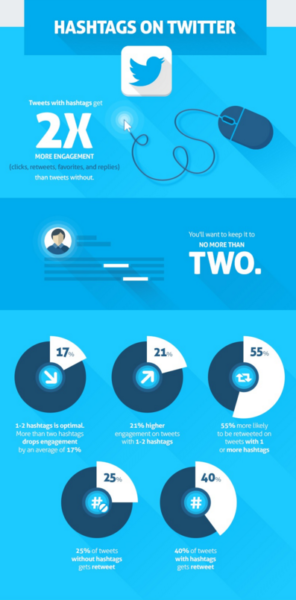Hashtags. We’ve all heard of them. In a world that seems to be dominated by social media, it’s hard not to know the term. You probably see them everywhere. Twitter, Instagram, even Facebook. But, do you actually know what they are used for? And more importantly, do you know how to use them yourself?
What Is a Hashtag?
The best way to explain what a hashtag is to go to the place that started it all. While hashtags are now used on pretty much every social media platform (to varying degrees of success), they originated in 2007 on Twitter. According to Twitter, “the # symbol, called a hashtag is used to mark keywords or topics in a tweet. It was created organically by Twitter users as a way to categorize messages.” Simply put, hashtags make your content easier to find and represent topics/categories that people are searching for.
Putting a hashtag before a keyword or frequently searched phrase allows you to more easily search Twitter for content related to that hashtag. In digital marketing, hashtags are crucial because they allow you to broaden your reach and make your content more engaging. If you run a small business and want to market yourself, hashtags can be very helpful because they allow you to go beyond your followers and reach audiences interested in specific keywords.
How Can I Use Hashtags and How Many Hashtags Should I Use?

Hashtags may seem complicated, but they are actually pretty easy to use. They are also easy to find. On Twitter, many of the trending topics are hashtags, so that’s always a good place to start when looking for an engaging hashtag to use. Hashtags related to your industry, motivational content, inspiring content, or certain days of the week are the most effective. Each day has at least one hashtag related to it, so if your content can relate to the hashtag for that day, it’s a good idea to try and tie it in.
For example, one of the most popular hashtags on Twitter and Instagram is #ThrowbackThursday or the abbreviation #TBT. Posts tagged with these hashtags are typically some sort of memory users want to share with their followers. Throwback Thursday posts usually feature a funny photo of you from years ago, a photo from a trip you wish you could take again, or something similar When you tag your post with #TBT, anyone who clicks on the hashtag on their timeline or searches for it can see your post.
So, say you’re a personal trainer and you want to share the success of one of your clients and make sure it reaches as many people as possible. You could post a before and after photo and tag it with #ThrowbackThursday #TBT, allowing far more users to potentially see the post than just your followers.
Don’t overdo it.
Once you get the hang of hashtags it’s easy to want to use them as much as possible. But, it’s important not to overdo it. #No #one #wants #to #read #a #post #like #this.
We’ve all seen that person on Facebook who uses way too many hashtags at the end of their post. Chances are you scrolled right past it once you saw three lines worth of hashtags. You’re not alone. Studies show that posts with too many hashtags have less engagement than posts with just one or two. In fact, according to Search Engine Journal, engagement on tweets with more than two hashtags drops by an average of 17%. But, posts with one or two hashtags have a 21% higher engagement rate and are 55% more likely to be retweeted.
Don’t just take our word for it. Even Twitter themselves say you shouldn’t over do it with the hashtags. They recommend using no more than two hashtags per tweet and we wholeheartedly agree. Anything with more than two hashtags is more likely to get ignored or scrolled over by users. No one likes a tweet that appears to be spam or is hard to read, and too many hashtags can make your tweets appear as both.
Should I Use Hashtags on Facebook?
Studies show that posts with one or two hashtags have a much higher engagement rate on Twitter, as well as Instagram. The jury is still out when it comes to using hashtags on Facebook, but many experts feel that using hashtags on Facebook is ineffective, and some even say it can do harm. We try to avoid using hashtags on Facebook, as we don’t think they’re right for the platform and are better suited for the other social media platforms. But, if you choose to use hashtags on Facebook, just be sure to limit it to one or two per post and make sure they’re relevant to what you’re posting.
Should I Use Hashtags on Instagram?
When it comes to Instagram, hashtags are very popular because they allow you to easily find content you’re interested in. They also allow you to find new accounts to follow, as users who are constantly showing up in your favorite hashtags are most likely people you want to see on your newsfeed. On Instagram, using more than two hashtags is more acceptable, but we still recommend only using three in your actual post. A great way to get the most out of hashtags on Instagram is to add them as a comment. This way you’re still using all the relevant hashtags, but you’re not spamming your caption with them.
How to Know Which Hashtags to Use?
The best hashtags should be both intentional and targeted. You should aim to have your hashtags seen by the right audience that will engage with your content. Here are simple factors to consider in terms of filtering down your hashtag subject-matter so that your chosen hashtags attract the right engagement:
- Think about which key phrases your ideal audience would search for given their demographic, problems, interests, or desires
- While certain hashtags may be popular and attract a large audience, they may not be the most suitable choice for a post; this is because it is easy for a post to get overlooked in a frequently-used hashtag pool that is constantly prioritizing newest posts
- The more specific and targeted the hashtag, the more likely it will perform well
- Location tags work wonderfully to narrow down an audience in a specific setting
- To get hashtag ideas, see which hashtags are used by brands you admire that have vast relevancy to your audience and topics
- Using trending hashtags may be a good idea, depending on your content and how targeted the hashtags are to your intended audience
- Always research your chosen hashtags to see if your post fits the context of other posts that use them
Now you have all the tools you need to start using hashtags correctly to market your business. But, if you think you need some more help, contact us at Idea Marketing Group today for more information on our monthly marketing packages.
Be sure to follow us on Twitter and Instagram to see our hashtag game in action. And, you can even try out our hashtag – #ideamktg!


